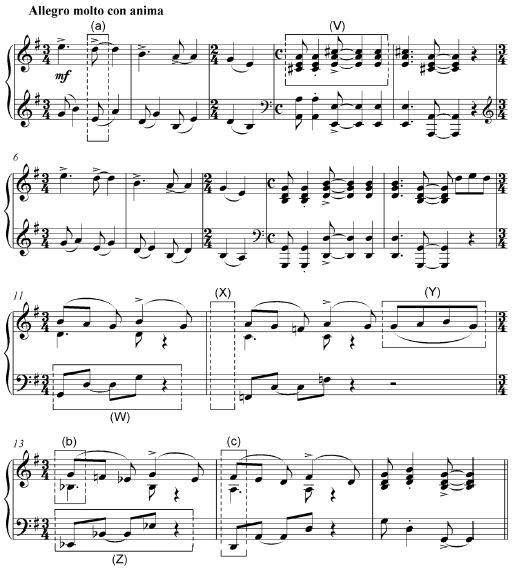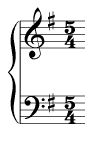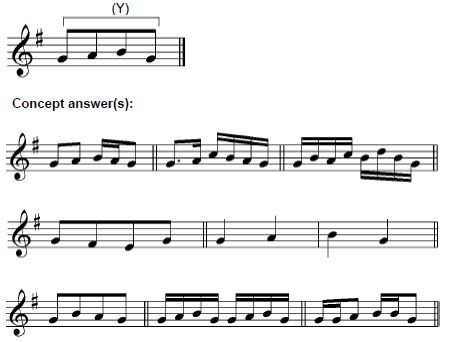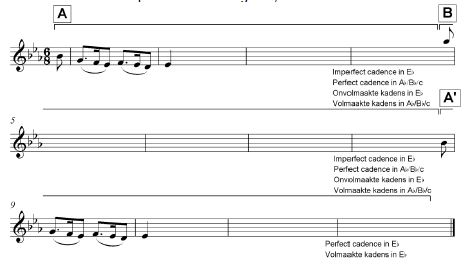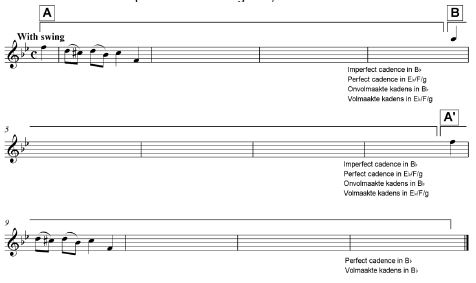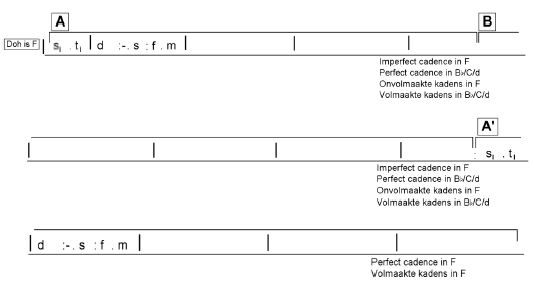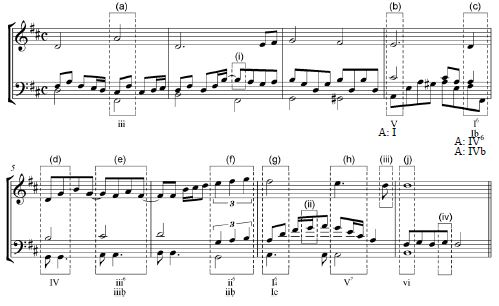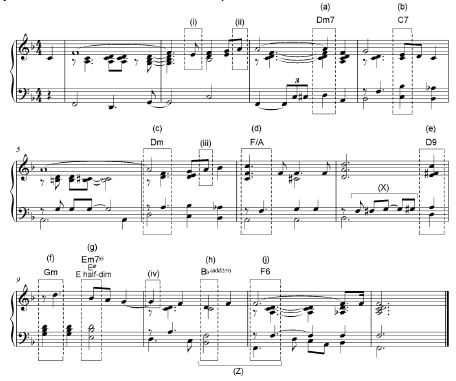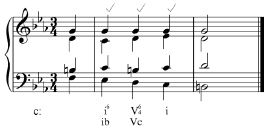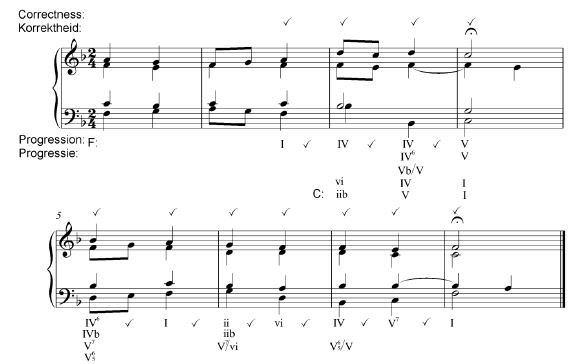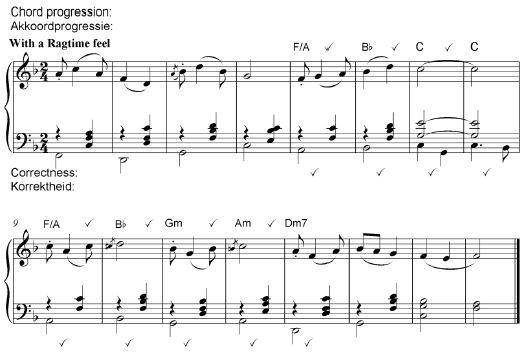MUSIC PAPER 1 GRADE 12 MEMORANDUM - NSC PAST PAPERS AND MEMOS NOVEMBER 2021
Share via Whatsapp Join our WhatsApp Group Join our Telegram GroupSECTION A: THEORY OF MUSIC (COMPULSORY) (90 minutes)
Answer QUESTION 1
AND QUESTION 2.1 OR 2.2 OR 2.3
AND QUESTION 3.1 OR 3.2
AND QUESTION 4.1 OR 4.2.
QUESTION 1 (25 minutes)
Study the extract below and answer the questions that follow.
1.1 How fast should this extract be performed? Make a cross (X) in the appropriate block.
Answer: Very lively and with energy 1 mark (1)
1.2 What type of scale is formed by the notes in the upper part of bars 1 to 3?
Answer:Pentatonic 1 mark(1)
1.3 Name the interval at (a) according to type and distance.
Answer: Minor 7th 1 mark No ½ marks(1)
1.4 Notate the inversion of the interval at (b).
Answer:
1 mark
No ½ marks
(Any note value is acceptable)
(1)
1.5 Name the triad at (c) according to type and position.
Answer: Major, Root position
½ + ½ = 1 mark (1)
1.6 Write the triad at (c) in the alto clef in first inversion in close position. Use minims.
Answer: Four optional answers
Clef = ½ mark
Notes = ½ mark
(1)
ONE correct answer = 1 mark (1)
1.7 Comment on the key(s) of this piece.
Answer:
- The piece starts in E minor and ends in G major
- The piece moves through the following keys: E minor, D major, G major, C major and Eb major
- The key signature indicates E minor or G major
- Can be considered as extended tonality as several keys are present
1.8 Compare the textures in bars 6 to 8 with those used in bars 9 to 10 and comment.
Answer:
| Bars 6 to 8 | Bars 9 to 10 |
| Two-layered linear, thin texture | Block chords, thick texture |
| Transparent (texture) | Chordal texture |
| Treble melody together with a single bass line accompaniment | Melody in treble voice with chordal accompaniment |
| Polyphonic (rudimentary) | Homophonic |
Any ONE comparison = 1 mark (1)
1.9 Identify the rhythmic feature used at (V).
Answer: Syncopation/accents on the weak beat
1 mark (1)
1.10 Rewrite (W) in the corresponding compound time. Insert the new time signature. Ensure that the music sounds the same.
Answer:
(2)
Correct time signature = ½ mark
Notation ½ mark per beat = 1½ marks
1.11 Insert the correct time signature in the space provided at (X) on the score.
Answer:
1 mark
No ½ marks
(No penalisation for an answer in the treble clef only)
(1)
1.12 Write a variation of the motive at (Y). Do NOT write a sequence. (Y)
Concept answer(s):
Accept any correct variation = 2 marks
Minus ½ mark per notation error (2)
1.13 Rewrite (Z) with an alternative rhythmic grouping. Do NOT change the sound of the music.
Answer:
1 mark
(1)
[15]
QUESTION 2 (25 minutes)
Answer QUESTION 2.1 OR QUESTION 2.2 OR QUESTION 2.3
2.1 Complete the opening below to form a twelve-bar melody in ternary form for any single-line melodic instrument of your choice. Name the instrument and supply a suitable tempo indication. Add dynamic and articulation indications in appropriate places.
Concept answer: Instrument: Saxophone/Clarinet/Flute/Trumpet/Violin, etc.
Tempo: Moderato/Allegretto, etc.
OR
2.2 Complete the opening below to form a twelve-bar melody in ternary form for any single-line melodic instrument of your choice. Name the instrument and supply a suitable tempo indication. Add dynamic and articulation indications at appropriate places.
Concept answer: Instrument: Saxophone/Clarinet/Flute/Trumpet/Violin, etc.
Tempo: Moderato/Allegretto, etc.
The melody will be marked according to the criteria below:
| DESCRIPTION | MARK ALLOCATION | ||
| Form and cadential points | 1 mark per phrase x 3 | 3 | |
| Correctness Note stems, beats per bar, accidentals, spacing, grouping | Minus ½ mark per error up to 2 marks | 2 | |
Quality - Quality of melody and suitability for chosen instrument | 9–10 | Excellent Coherent and musical; phrases imaginatively define the form; opening motive innovatively continued; successful use of key; melodic shape and range masterfully handled; creative approach to choice of pitches and rhythm | 10 |
| 7–8 | Good Correct and musical; phrases clearly indicate the form; opening motive sensibly continued; stable key; melodic shape and range satisfying; choice of pitches and rhythm accurate | ||
| 4–6 | Average Musically not convincing; phrases not all clear; opening motive not well utilised; key unstable; melodic shape and range suspect; choice of pitches and rhythm unimaginative | ||
| 0–3 | Not acceptable No musical sense; no sense of phrasing; opening motive ignored; no sense of key; no melodic shape; pitches and rhythm random | ||
| TOTAL | Markers may use ½ marks | 15 | |
[15]
OR
2.3 Complete the opening below in solfa notation to form a twelve-bar melody in ternary form for voice. Name the voice type and supply a suitable tempo indication. Add dynamic indications at appropriate places. Do NOT add lyrics.
Concept answer: Voice: Soprano/Alto/Tenor/Baritone/Bass
Tempo: Moderato/Allegretto, etc.
The melody will be marked according to the following criteria:
| DESCRIPTION | MARK ALLOCATION | ||
| Form and cadential points | 1 mark per phrase x 3 | 3 | |
| Correctness Note stems, beats per bar, accidentals, spacing, grouping | Minus ½ mark per error up to 2 marks | 2 | |
Quality - Quality of melody and suitability for chosen instrument | 9–10 | Excellent Coherent and musical; phrases imaginatively define the form; opening motive innovatively continued; successful use of key; melodic shape and range masterfully handled; creative approach to choice of pitches and rhythm | 10 |
| 7–8 | Good Correct and musical; phrases clearly indicate the form; opening motive sensibly continued; stable key; melodic shape and range satisfying; choice of pitches and rhythm accurate | ||
| 4–6 | Average Musically not convincing; phrases not all clear; opening motive not well utilised; key unstable; melodic shape and range suspect; choice of pitches and rhythm unimaginative | ||
| 0–3 | Not acceptable No musical sense; no sense of phrasing; opening motive ignored; no sense of key; no melodic shape; pitches and rhythm random | ||
| TOTAL | Markers may use ½ marks | 15 | |
[15]
QUESTION 3 (10 minutes)
Answer QUESTION 3.1 OR QUESTION 3.2.
3.1 Study the extract below and answer the questions.
3.1.1 Figure the chords at (a) to (h) on the score using Roman numerals, e.g. E: viio6/viiob.
Answer: See score
1 mark per chord = 8 marks
Minus ½ mark if inversion is incorrect (8)
3.1.2 Name the final cadence and figure the last chord at (j) on the score.
Answer:
Interrupted cadence = 1 mark
See score = 1 mark
(2)
3.1.3 Name the types of non-chordal notes at (i) to (iv).
Answer
- Suspension = 1 mark
- Passing note = 1 mark
- Anticipation = 1 mark
- (Upper) Auxiliary note = 1 mark
(4)
3.1.4 Explain the G# in bar 3.
Answer:
- Chromatic note in D major
- Leading note of A major
- Leading note of the dominant/relative key
- Chromatic passing note
- Part of secondary dominant (Vb/V)
Any ONE = 1 mark (1)
[15]
OR
3.2 Study the extract below and answer the questions.
3.2.1 Identify the chords (a) to (h) and write chord symbols in the spaces above the chords, e.g. Bb/D.
Answer:See score
1 mark per chord = 8 marks
Minus ½ mark if inversion is incorrect (8)
3.2.2 Name the cadence which is formed at (Z) and write the chord symbol at (j) on the score.
Answer:
Plagal cadence = 1 mark
See score = 1 mark
(2)
3.2.3 Name the types of non-chordal notes at (i) to (iv).
Answer:
- (Lower) Auxiliary note 1 mark
- Anticipation 1 mark
- Passing note 1 mark
- Suspension (4) 1 mark
3.2.4 Comment on the tenor part in bar 8 at (X).
Answer:
- Chromatic passage
- Contains syncopation
- Quavers create a forward drive
Any ONE = 1 mark (1)
[15]
QUESTION 4 (30 minutes)
Answer EITHER QUESTION 4.1 OR QUESTION 4.2.4.1
4.1.1 Complete the following harmonic progression in four parts by inserting a passing second inversion pattern.
1 mark per chord = 3 marks
Minus ½ mark per error up to a maximum of 1 mark per chord (3)
4.1.2 Complete the four-part vocal harmonisation below by adding the alto, tenor and bass parts.
Concept answer:
The harmonisation will be marked according to the criteria below:
| DESCRIPTION | MARK ALLOCATION | |
| Correctness Notation, doubling, spacing, voice leading | Minus ½ mark per error but not more than 1 mark per chord | 11 |
| Chord progression Choice of chords, correct use of cadence | 1 mark between each pair of chords (except between bars 4 and 5) | |
| Quality Musicality, non-chordal notes, awareness of style, creativity, e.g. use of cadential 6/4 and/or a sequence | Excellent = 3½–4 marks Good = 2½–3 marks Average = 1½–2 marks Weak = 0–1 marks | |
| Note to marker: Mark out of 24 must not contain a ½ mark | 24 (÷ 2) | |
| TOTAL | 12 | |
(12)
[15]
Candidates must be credited for a different/creative and correct harmonisation not given in the memorandum. The figuring serves as a guide for the marker, but no marks are allocated for the symbols as such.
OR
4.2
4.2.1 Complete the harmonic progression below by filling in chords in the bass clef. Use minims. (5)
1 mark per chord = 5 marks
Minus ½ mark per error up to a maximum of 1 mark per chord
4.2.2 Complete the piece below by adding appropriate harmonic material. Continue in the style suggested by the given material in bars 1 to 4.
Concept answer:
The answer will be marked according to the criteria below:
| DESCRIPTION | MARK ALLOCATION | ||
| Chord progression Choice of chords, correct use of cadence | 1 mark between each pair of chords (except between bars 8 and 9) | 7 | |
| Correctness Notation, spacing, voice leading | Minus ½ mark per error but not more than 1 mark per chord | 9 | |
| Quality Musicality, non-chordal notes, awareness of style, creativity, e.g. use of accidentals | Excellent Good Average Weak | = 3½–4 marks = 2½–3 marks = 1½–2 marks = 0–1 marks | 4 |
| Note to marker: Mark out of 20 must not contain a ½ mark | (20 ÷ 2) | ||
| TOTAL | 10 | ||
(10)
[15]
Candidates must be credited for a different/creative and correct harmonisation not given in the memorandum. The figuring serves as a guide for the marker, but no marks are allocated for the chord symbols as such.
TOTAL SECTION A: 60
SECTIONS B, C, D, E: GENERAL MUSIC KNOWLEDGE (90 minutes)
| Note to marker: One mark will be allocated for each correct fact. Candidates must be credited for any correct answer not given in this marking guideline. |
SECTION B: GENERAL (COMPULSORY)
QUESTION 5
Answer:
5.1
5.1.1 C
5.1.2 D
5.1.3 B
5.1.4 C
4 x 1 (4)
5.2 Original creative output (music composition/songs/merchandise etc.) owned by the composer/artist 1 mark (1)
5.3
- They protect the rights of authors, composers and music publishers
- They administer the copyright of the member's music
- They issue licenses to music users, e.g. schools, concert halls, shopping centres, etc.
- They collect license fees
- They distribute the royalty payments to members
- They administer a pension fund for members
- They organise competitions
- They commission new works
TWO correct facts (2)
5.4
- The royalties that are paid to composers/authors/publishers when their recorded music or cover version/remix is copied and sold as a hardcopy or online, e.g. CD, Mp3, digital downloads (streaming)
OR - In order to produce a recorded music product, mechanical or digital, a license fee must be payed – this is referred to as the mechanical rights
1 mark (1)
5.5
- Obtain permission from the copyright owner to use their material
- Pay a license fee to the composer's collection agency
2 marks
(2)
TOTAL SECTION B: 10
SECTION C: INDIGENOUS AFRICAN MUSIC (IAM)
| Note to marker: Although the marking guideline is in bullet form the learners may answer in full sentences. |
QUESTION 6
Answer:
6.1
6.1.1 D
6.1.2 D
6.1.3 C
6.1.4 B
6.1.5 A
5 x 1 (5)
6.2
6.2.1 C
6.2.2 D
6.2.3 B
6.2.4 A
4 x 1(4)
6.3
Answer:
6.3.1 Tshikona
- Performed during important occasions, e.g. installation of a new king, or commemoration of the death of a king
- Performed by both men and women
- Men play pipes and women play drums
- Each pipe is assigned its own pitch
- Singing accompanied by traditional vhaVenda instruments, e.g.
- Mbila mutondo – 21-key xylophone
- Mbila dzamadeza – 27-key lamellophone
- Ngoma – huge pegged drum
| THREE correct facts Only ONE mark for accompanying instruments |
(3)
OR
6.3.2 Borankana
- Used for entertainment during tribal activities and traditional ceremonies
- Performed by both young and old men
- Women and girls play the role of singers and body percussionists
- Uses the Setlhako and Sephuma rhythms
- Clapping and leg rattles accompany the singing and dancing
THREE correct facts (3)
OR
6.3.3 Muchongolo
- Singing and dancing used to energise warriors in preparation for war and used as entertainment after victory
- Performed by men (warriors)
- Characterised by energetic bursts of high lifting of feet and stomping
- Drums are played in polyrhythmic fashion
- The voices are accompanied by a traditional ensemble, e.g.
- Xigubu (double-headed drum)
- Ncomone (type of tambourine)
- Xitiringo (three-hole transverse flute)
- Xitende (large gourd-resonated braced bow)
- Mohambi (10-key xylophone)
THREE correct facts
Only ONE mark for accompanying instruments (3)
OR
6.3.4 Mohobelo
- Used for entertainment during the chief's ceremonial procedures, e.g. swearing in of new chief or honouring of the chief
- It is performed by men
- Three main movements occur, e.g.
- Bohobela (high kicks)
- Molapo (leaps and twists)
- Phethola letsoho (hand movements)
- Singing is accompanied by drums with shakers and clapping
THREE correct facts
Only ONE mark for movement (3)
OR
6.3.5 Isitshikiza
- Historically performed for the king's pleasure
- Warriors re-enact stories through dance during festivals to lift their morale
- Nowadays isitshikiza is performed at social gatherings, weddings or first fruits ceremonies
- It was also commonly performed for injelele, a rainmaking ceremony
- Danced by both men and women
- Powerful stomping of feet on the ground employed
- Women do not lift their feet higher than the knees when dancing
- Two rhythms are used one after the other to avoid monotony
THREE correct facts (3)
OR
6.3.6 Indlamu
- A recreational dance
- Danced by both men and women
- Stomping movements are executed in unison
- The end of the dance indicated by the team moving forward and executing a fall
- The leader (igosa) introduces new dance movements
- A group of singers/clappers and a drummer form an integral part of the dance performance
- Female voices accompany the female teams, and male voices the male teams
THREE correct facts (3)
6.4 Answer:
- The band consists of a leading vocalist and backing vocalists, lead guitar, bass guitar, keyboard and drums
- Organ or synthesised organ sound often added for organ-based vocal mbaqanga
- Guitar driven sound in a purely instrumental mbaqanga
- Bass drum mimics the stomping of the indlamu (Zulu dance performance)
- The performance usually begins with a short guitar introduction
- A call and response is often utilised between the lead vocalist and backing vocalists (vocal mbaqanga)
- The song follows a I-IV-V-I chord cycle
- Crepitation is often used
THREE correct facts (3)
[15]
QUESTION 7
Answer:
Dress code
- The isicathamiya groups dressed in suits, white shirts, white gloves and shiny black shoes (reminiscent of the American minstrel singers), with the leader sometimes dressed in contrasting colours to the group
- They may dress in African shirts and white sneakers
1 mark
(1)
Stage performance
- The actual performance may start offstage, continuing while they enter
- The group hums the pitch of the first song
- The leader introduces the members of the group
- There is waving of hands to greet the audience
- The leader initiates the song and the group then responds (call and response)
- Usually the beginning of the song is sung with the group standing still under the instruction of the leader in a makwaya (choral) setting
- As the song progresses the leader will give the first dance steps and the group follows and incorporates leg movements (isteps/ukucothoza) with their body movements synchronised to the song
- During the performance the group uses crepitations to evoke excitement in the audience
- The audience responds with ululations to show appreciation and affirmation
FOUR correct facts (4)
[5]
QUESTION 8
Answer:
- Music is a social activity in which everyone participates
- Music highlights African values such as co-operation and unity (Ubuntu)
- Used at celebration rituals (birth, rites of passage, marriage, death), e.g.
- In some cultures a song is composed for a child at birth which is used throughout their lives (at initiation, marriage and death)
- Accompany work (digging, chopping, harvesting), e.g.
- Rhythms created by the physical labour are incorporated into the music that accompanies the labouring making the work lighter
- Praise and commentary (izibongo), e.g.
- Teaching about a person's origins
- Recount and celebrate history
- African music combines dance, playing instruments and singing as a cultural ritual expression
- The African drum is the most significant instrument as it is the heart of the community and reflects their moods and emotions
- The beat of the drum keeps the dancers together and dictates the dance patterns
- The human body is often used as a percussion instrument through, e.g. clapping
- Dance movements are an extension of the rhythms of the music
- Dance reflects the sense of unity in community
- Music is passed on (mostly orally) from generation to generation and plays an essential role in binding the community together
EIGHT correct facts
[8]
QUESTION 9
Answer:
- Izibongo/direto is a type of (self)-praise which a musician recites at the beginning or in the middle of a song
- There may be instrumental accompaniment in the background
- The main purpose is to introduce the performer by reciting praise names and ancestry
- Other purposes include, e.g.
- Recalling historical incidents and memorable achievements
- To transmit social consciousness while also entertaining the audience
- It is usually spoken in a fast tempo
- There is no single, constant 'melodic' sequence, e.g.
- The change in pitch relies on the inflection of speech which then determines the contour
- The praise poetry can be chanted to a drum beat or intoned a cappella
- Call and response is sometimes used where, e.g.
- The poet speaks (calls) a line and the audience responds on cue
- Poetic features such as repetition, parallelism and imagery are used
SEVEN correct facts[7]
QUESTION 10
Answer:
Example of an introduction
Maskanda is a subgenre of Zulu folk music often accompanied on acoustic guitars using specific techniques and percussive performance sound.
Development of maskanda as a male performance style
- Traditional African masculinity required men to work in order to support their families while women stayed home to take care of the children
- Apartheid forced men to leave their home and find work in the cities
- In the cities they lived in male-only mining compounds
- They started to make music that reminded them of home using instruments (guitar) which they obtained cheaply in the cities
- Western instruments provided new opportunities for musicians
- The opportunity to record the music and make some money reinforced the system of the man being the provider
FOUR correct facts
The influence of umakhweyane/ugubhu (gourd-bow) music
- The form and structure of maskanda are derived from umakhweyane performance practice
- The inclusion of izibongo comes from umakhweyane
- Tonality is structured around contrasting triads either a semitone or a tone apart as used in umakhweyane
- Specific tuning of maskanda guitar is influenced by the melodic overtones created on the umakhweyane
- The use of the pentatonic scale by umakhweyane forms the basis of maskanda improvisation
- The percussive playing style is reminiscent of umakhweyana music
- The guitar in maskanda serves as self-accompaniment to singing just as in umakhweyana
FIVE correct facts
Artists
- Mfaz'Omnyama
- Inkunz' Emdaka
- Khuzani
ONE/TWO correct answer(s)
Songs/albums
- Kuke Kwagijim' Iveni
- Umama
- Umshado
ONE/TWO correct answer(s)
Up to a maximum of 3 marks for Artists/Songs/Albums
Example of a conclusion
KwaZulu-Natal is rich in maskandi musicians which now includes female bands. They continue to develop a rich musical repertoire using this style of guitar playing.
The essay will be marked according to the criteria below:
| CRITERIA | MARK ALLOCATION | ||
| Maskanda as a male performance style | 4 | ||
| The influence of umakhweyane/ ugubhu (gourd-bow) | 5 | ||
| Artists and songs/albums | 3 | ||
| Logical presentation and structure of the essay | Excellent An introduction, conclusion, with a substantial argument in the body of essay evident. | = 3 marks | 3 |
| Good An introduction, conclusion, with a reasonable argument in the body of essay evident. | = 2-2½ marks | ||
| Average An introduction, conclusion, with an insignificant argument in the body of essay evident. | = 1½ marks | ||
| Below average An introduction, conclusion with a weak argument in the body of essay evident. | = 1 mark | ||
| Weak A single paragraph: A poor attempt at an essay. | = ½ mark | ||
| Not acceptable Only facts in bullet form. | = 0 marks | ||
| TOTAL | 15 | ||
[15]
TOTAL SECTION C: 50
OR
SECTION D: JAZZ
| Note to marker: Although the marking guideline is in bullet form the learners may answer in full sentences. |
QUESTION 11
Answer:
11.1
11.1.1 A
11.1.2 A
11.1.3 C
11.1.4 D
11.1.5 B
5 x1 (5)
11.2
- Major
- Guitar/organ/electronic keyboard
2 x 1 (2)
11.3
11.3.1 C
11.3.2 A
11.3.3 D
11.3.4 B
4 x 1 (4)
11.4
Answer:
- The band consists of a leading vocalist and backing vocalists, lead guitar, bass guitar, keyboard and drums
- Organ or synthesised organ sound often added for organ-based vocal mbaqanga
- Guitar driven sound in a purely instrumental mbaqanga
- Bass drum mimics the stomping of the indlamu (Zulu dance performance)
- The performance usually begins with a short guitar introduction
- A call and response is often utilised between the lead vocalist and backing vocalists (vocal mbaqanga)
- The song follows a I-IV-V-I chord cycle
- Crepitation is often used
FOUR correct facts (4)
[15]
QUESTION 12
Answer:
- Mainly influenced by mbaqanga
- A mixture of hard-driving blues and wild experimentalism with a unique South African flavour/character
- Combined kwela with more progressive ideas retaining an African-flavoured avant-garde sound
- Influenced by music of Duke Ellington, Thelonious Monk, Charles Mingus, Béla Bartók, Schoenberg, Dollar Brand and Cecil Barnard
- Instrumentation of the Big Band retained
- Moved away from the arrangements of the typical Big Band style
- Freely improvised music not following a set chord structure
- Flexibility is stressed in performance
FIVE correct facts [5]
QUESTION 13
Answer:
Local influences
- Cape Malay folksong influences exemplified by ghoema-dance which gives his piano writing its raw energy (Cape minstrel)
- Characteristic rhythm of local ghoema drum contributes to the ostinato left-hand accompanying figure of
- Kwela skiffle-like rhythms
- Dance band music styles (langarm, two-step)
- Punchy syncopated melodic feel of marabi jazz
- Melodic imitation of the penny whistle
- The use of the three-chord harmonic progressions/cycles found in church hymns and other styles, e.g. mbaqanga (township jive) as in Mannenberg
- Uses traditional music of the amaXhosa and incorporates elements of older San and Khoi music, e.g. oscillating between tonic and supertonic triads used in the bow
songs of the amaXhosa and amaZulu
FOUR correct facts (4)
International influences
- Modern folksong harmonies of Dutch/European origins
- Dance band music styles (swing, boogie, foxtrot, quickstep)
- Syncopated feel of ragtime
- Humorous character of American minstrel music
- Classical piano style
- Jazz piano influences of Duke Ellington and Thelonious Monk
- Sturdy block chords and sentimental harmonies from gospel music
- Sufi (Islamic) chanting and drumming
- In slow tempo
- The atmospheric use of the full piano range and pedalling
- Use of minor scale with raised 4th and 7th and flattened 2nd
- The Pilgrim compares well with Indonesian orientalism found in piano writing of North African composers
- Soft dynamics and gently-stroked chords portraying sentimental European folk music
THREE correct facts (3)
Maximum of 1 mark for song or work named (1)[8]
QUESTION 14
Answer:
- Written for solo player with accompanying band
- Penny whistle used initially as lead instrument
- Saxophone substitutes penny whistle as lead instrument
- Accompanied by guitar(s)/banjo and drums initially
- Cyclic chord structure
- Chord progressions (I – IV – I64 – V or I – IV – V – I)
- Moderate to upbeat tempo
- Skiffle-like beat with jive/swing rhythms
- Weaved a secondary melodic line around the main tune when there is more than one melodic player
- Melodic material developed in improvisation
SEVEN correct facts
Maximum of 2 marks for instrumentation [7]
QUESTION 15
Answer:
Example of an introduction
Marabi is a piano-based, ragtime-influenced type of dance music with a repeated harmonic progression
Origins of instruments
- Solo 'piano-men' emerged with the rise of American ragtime, Dixieland and jazz in the 1900s
- Owners of entertainment venues bought their own pianos/organs to compete for the services of popular pianists and organists in order to attract patrons
- Influence of brass and fife-and-drum bands of British forces during the Anglo-Boer war (1899–1902)
TWO correct facts
Instrumentation
- Urban Bapedi used brass instruments to play Western tunes
- Small ensembles consisting of piano, brass, woodwind, violin, banjo, and drums emerged in the 1920s and 1930s
- The Flying Jazz Queens: voices, rhythm guitar, lead guitar, saxophone and drum kit
- The Manhattan Brothers: voices, piano, guitar and clarinet and drum kit
- Indunduma (marabi piano vamp style) is incorporated into many traditional songs by instrumentalists (guitarists and violinists)
THREE correct facts
Style characteristics
- Keyboard style (sometimes cheap pedal organs) linked to American jazz, ragtime and blues, with roots in African tradition
- The sound of marabi was intended to draw people's attention and get them dancing
- Typical cyclic four-bar progressions were I-IV-I64-V or I-IV-V-I(V) or I-ii6-V-I(V)
- The cyclic progressions repeated in varying vamping patterns allowed people to easily pick up the feel and rhythm of the song
- It allowed people to dance for a long time without having to know the song
- The lilting melodies and catchy rhythms found their way into the sounds of popular dance bands
- Melodies were influenced by indigenous African hymns, popular songs and African- American music
- Focus was on repeated melody and not improvisation
- Rhythms were based on standard patterns reflecting a basic drum pattern commonly found in Nguni music
- Stylistic exchange between rural neo-traditional African music and marabi took place to create new rhythms and inventive, comical footwork
- Rural dances: amaXhosa mabokwe
- Neo-traditional forms: amaZulu guitar songs of roving abaqhafi 'street cowboys'
- Emerging urban styles: amaXhosa itswari
- AmaXhosa thula ndivile: three-chord harmonic format that serves to signal other players in the band to tone down for new material to be introduced
Artist/Band and music example
- The Manhattan Brothers: Jikela Emaweni
- The Flying Jazz Queens: Langa More
TWO correlating correct facts
Example of a conclusion
Marabi established itself as an original South African jazz style which influenced the direction of future local jazz.
The essay will be marked according to the criteria below:
| CRITERIA | MARK ALLOCATION | ||
| Origins of instruments | 2 | ||
| Instrumentation | 3 | ||
| Style characteristics | 5 | ||
| Artist/band and music example | 2 | ||
| Logical presentation and structure of the essay | Excellent An introduction, conclusion, with a substantial argument in the body of essay evident. | = 3 marks | 3 |
| Good An introduction, conclusion, with a reasonable argument in the body of essay evident | = 2-2½ marks | ||
| Average An introduction, conclusion, with an insignificant argument in the body of essay evident. | = 1½ marks | ||
| Below average An introduction, conclusion with a weak argument in the body of essay evident. | = 1 mark | ||
| Weak A single paragraph: A poor attempt at an essay. | = ½ mark | ||
| Not acceptable Only facts in bullet form. | = 0 marks | ||
| TOTAL | 15 | ||
TOTAL SECTION D: 50
OR
SECTION E: WESTERN ART MUSIC (WAM)
Note to marker: Although the marking guideline is in bullet form the learners may answer in full sentences.
QUESTION 16
Answer:
16.1
16.1.1 C
16.1.2 D
16.1.3 D
16.1.4 C
16.1.5 D
5 x 1 (5)
16.2
- An orchestral composition in one movement
- Romantic period genre
- May be based on a poem, novel, painting, descriptive/programmatic title or other non-musical source
- Uses a traditional form-type (sonata form)
THREE correct facts (3)
16.3
- The tone poem always has a specific programme provided by the composer while the concert overture has a descriptive title and suggested programmatic content
- The tone poem has a free form which follows the programmatic content while the concert overture usually is in sonata form
- The tone poem is usually longer than a concert overture
- The tone poem was conceptualized from symphonic music, while the concert overture has its roots in an opera overture
2 marks
(2)
16.4
- Showcases virtuosity in a vocal solo performance accompanied by an orchestra
- It has a reflective and contemplative function
- It often expresses emotion through music
TWO correct facts (2)
16.5
- Italian
1 mark (1)
16.6
- The Barber of Seville by Rossini
- Carmen by Bizet
- La Traviata by Verdi
- Madame Butterfly by Puccini
Any ONE opera with correlating composer = 2 marks
Any ONE opera with incorrect composer information = 1 mark
No mark for composer only
(2)
[15]
QUESTION 17
Answer:
Structure
- Remains within the framework of the classical model of sonata form
- Uses clear balanced phrases and themes
- Motive writing and development thereof
Orchestra type
- Uses a standard classical orchestra
Harmony
- Modulation to near related keys (B minor/D Major)
- Uses standard common practice (functional) harmonic progressions
Melody
- Motivic structure in opening section; typical broken chord figure
- Balanced phrases
Texture
- Uses mainly a homophonic texture
- A glimpse of polyphonic writing
FIVE correct facts
Maximum of 1 mark per item[5]
QUESTION 18
Answer:
General characteristics
- Singspiel is a type of opera
- Text is in German
- A musical and staged dramatic work
- A popular form of entertainment
- Contains spoken dialogue
THREE correct facts (3)
Storyline essentials
- Includes elements of magic,
- fantastical creatures,
- exotic and legendary places
- fairy-tales
- Plots are generally comical
- Plots are romantic in nature
- Exaggerated characterisations of good and evil
THREE correct facts (3)
Musical features
- Elaborate and expressive arias
- Contrasting strophic and folk-like songs
- Ensembles, duets and choruses included
- Includes elements of opera seria, opera buffa and bel canto (in some arias)
TWO correct facts (2)
[8]
QUESTION 19
19.1 Answer:
Symphony/sonata/concerto/concert overture/string quartet/chamber music trio
1 mark (1)
19.2
| Exposition | Recapitulation |
|
|
SIX correlating facts (3+3) (6)
[7]
QUESTION 20
Answer:
Example of an introduction
Beethoven's new and original ideas developed and enhanced the symphonic model of the Classical era.
Structure and form
- The programmatic idea influences the resulting overall structure
- All the movements are given titles instead of mere tempo indications
- Consists of five movements instead of the usual three or four
- He added the fourth movement between the conventional third and fourth movements of a Classical symphony
- The third movement moves into the fourth movement, and the fourth movement moves into the fifth movement without interruption
- The uninterrupted flow of the last three movements creates a sense of unity and continuity creating one long movement (movements 3 to 5)
- The conventional form types within the symphonic work were changed to allow for more freedom of expression
- Fourth movement – free (episodic) form allowing freedom for the tone painting of a storm
- Fifth movement – the recurring rondo theme expresses the sentiments of the shepherds and the mood of thankfulness
SIX correct facts
Instrumentation/orchestration
- He added more instruments to the orchestra to enhance orchestral colour
- Added piccolo plays shrill high notes to create terror and tension
- Added two trombones to add strength and intensity to the climax of the storm
- The cello quintuplet figures and double bass quadruplets create a continuous rumbling in the storm
- The timpani tremolo represents the character of thunder
- The use of the flute playing softly and gently as a link to the fifth movement suggests a return to the pastoral setting after the storm
- Alpine horn call depicted by the call and echo of the clarinet and horn at the beginning of the fifth movement re-establishes the calm, pastoral mood
THREE correct facts
Maximum of 2 marks for instrument additions
Dynamics
- His use of dynamics helps to portray the programmatic content
- A wide dynamic range in his fourth movement from pp-raindrops to ff-thunder strokes
- pp-tremolo on the timpani at the start of the fourth movement indicating the beginning of the storm
- sf used at the climax of the storm
- The fifth movement ends pianissimo followed by two thunderous fortissimo chords to end off the symphony
THREE correct facts
Example of a conclusion
Beethoven's innovations to the symphonic model continue to inspire composers of the symphony.
The essay will be marked according to the criteria below:
| CRITERIA | MARK ALLOCATION | ||
| Structure and form | 6 | ||
| Instrumentation/orchestration | 3 | ||
| Dynamics | 3 | ||
| Logical presentation and structure of the essay | Excellent An introduction, conclusion, with a substantial argument in the body of essay evident. | = 3 marks | 3 |
| Good An introduction, conclusion, with a reasonable argument in the body of essay evident. | = 2-2½ marks | ||
| Average An introduction, conclusion, with an insignificant argument in the body of essay evident. | = 1½ marks | ||
| Below average An introduction, conclusion with a weak argument in the body of essay evident. | = 1 mark | ||
| Weak A single paragraph: A poor attempt at an essay. | = ½ mark | ||
| Not acceptable Only facts in bullet form. | = 0 marks | ||
| TOTAL | 15 | ||
[15]
TOTAL SECTION E: 50
GRAND TOTAL:120
